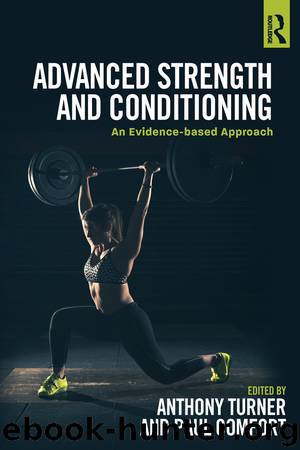Advanced Strength and Conditioning by Anthony Turner & Paul Comfort

Author:Anthony Turner & Paul Comfort
Language: eng
Format: epub
Publisher: Routledge
Compression garments
Compression garments are increasingly used within sport. It is claimed that their use can improve recovery from strenuous exercise (Hill et al., 2014a). The purported physiological benefits may be linked to the creation of an external pressure gradient and/or enhanced blood flow that both may reduce swelling, and/or enhance the removal of waste products and muscle metabolites (Hill et al., 2014a).
Similar to other recovery interventions, the results are equivocal, which is likely due to the variety in mode of exercise, application of the garment, training status of participants and/or outcome measures utilised. In a recent meta-analysis, Hill et al., (2014a) found that when compression garments are worn after, or during and after strenuous exercise, there is a moderate benefit in reducing muscle soreness and CK concentrations, and improvements in recovery of muscle strength and power. However, in the same year, the same group demonstrated that the use of a lower limb compression garment worn for 72 hours after a marathon had no effect on improving recovery of muscle performance or the removal of serum markers of muscle damage and inflammation (Hill et al., 2014b). There was, however, a significant reduction in perceived levels of muscle soreness at 24 hours in those that wore the compression garment.
There may be many reasons for the conflicting findings, however; much of the discrepancy in results has been linked to the pressure exerted by the garment. A variety of compression garments are utilised in research and the pressure applied, which is not routinely reported, is significantly affected by garment type, size and posture assumed by the athlete (Brophy-Williams et al., 2015). In respect of this, recent research has demonstrated that the pressure exerted likely plays a role in the efficacy of compression garments. Hill et al., (2017) compared the effectiveness of high (14.8 ± 2.2 mmHg at the thigh; 24.3 ± 3.7 mmHg at the calf) and low (8.1 ± 1.3 mmHg at the thigh and 14.8 ± 2.1 mmHg at the calf) compression garments on recovery following drop jumps. The authors concluded that the pressure exerted by a compression garment did affect recovery following EIMD, with a higher pressure more beneficial for recovery of muscle function (Hill et al., 2017), a key consideration for applied practitioners and athletes.
Although there is evidence to suggest garments that exert high pressures are more effective for recovery, there are large variations in the degree of pressures exerted across a population. This is likely due to differences in limb and tissue size (Hill et al., 2017). However, athletes must be aware that higher does not necessarily equal better, and there may be an optimal level of pressure required. Although low levels of compression may be insufficient to impact on physiological processes such as blood flow and osmotic pressure, compression that is too high may restrict blood flow (Hill et al., 2017) and thus negatively impact on recovery. Defining the optimal level of pressure is difficult due to reasons previously discussed (individual variation in limb and tissue size).
Download
This site does not store any files on its server. We only index and link to content provided by other sites. Please contact the content providers to delete copyright contents if any and email us, we'll remove relevant links or contents immediately.
Bodyweight Strength Training by Jay Cardiello(7185)
Tools of Titans by Timothy Ferriss(6948)
Born to Run: by Christopher McDougall(6260)
Inner Engineering: A Yogi's Guide to Joy by Sadhguru(5897)
Asking the Right Questions: A Guide to Critical Thinking by M. Neil Browne & Stuart M. Keeley(4576)
The Fat Loss Plan by Joe Wicks(4239)
Bodyweight Strength Training Anatomy by Bret Contreras(4060)
Yoga Anatomy by Kaminoff Leslie(3701)
Science and Development of Muscle Hypertrophy by Brad Schoenfeld(3578)
Dynamic Alignment Through Imagery by Eric Franklin(3489)
The Four-Pack Revolution by Chael Sonnen & Ryan Parsons(3484)
ACSM's Complete Guide to Fitness & Health by ACSM(3469)
Yoga Anatomy by Leslie Kaminoff & Amy Matthews(3396)
Bodyweight Strength Training: 12 Weeks to Build Muscle and Burn Fat by Jay Cardiello(3351)
The Ultimate Bodybuilding Cookbook by Kendall Lou Schmidt(3320)
Exercise Technique Manual for Resistance Training by National Strength & Conditioning Association(3292)
Nutrition for Sport, Exercise, and Health by Spano Marie & Kruskall Laura & Thomas D. Travis(3236)
Nutrition for Sport, Exercise, and Health by Marie Spano & Laura Kruskall & D. Travis Thomas(3232)
Yoga Therapy by Mark Stephens(3222)
